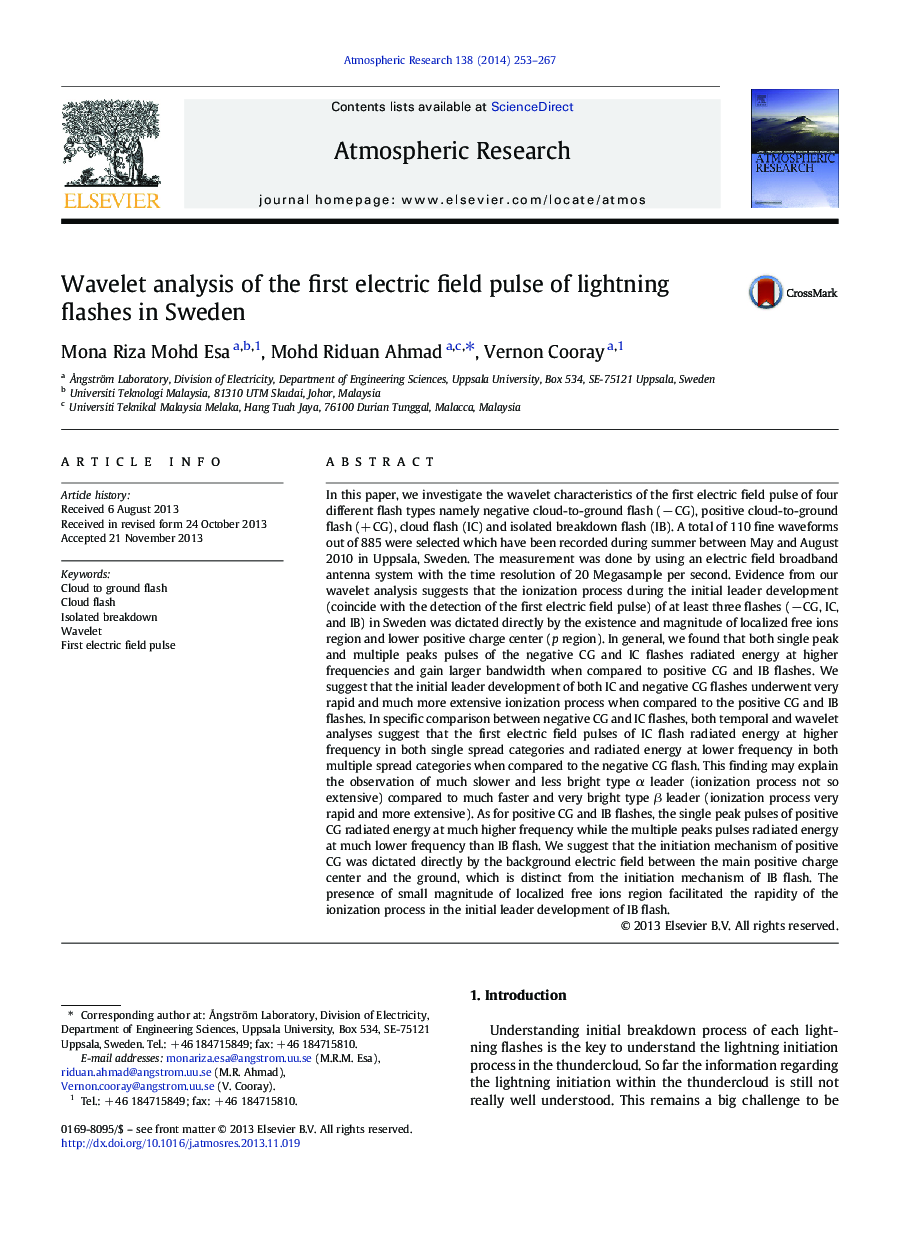| کد مقاله | کد نشریه | سال انتشار | مقاله انگلیسی | نسخه تمام متن |
|---|---|---|---|---|
| 6343649 | 1620532 | 2014 | 15 صفحه PDF | دانلود رایگان |
عنوان انگلیسی مقاله ISI
Wavelet analysis of the first electric field pulse of lightning flashes in Sweden
دانلود مقاله + سفارش ترجمه
دانلود مقاله ISI انگلیسی
رایگان برای ایرانیان
کلمات کلیدی
موضوعات مرتبط
مهندسی و علوم پایه
علوم زمین و سیارات
علم هواشناسی
پیش نمایش صفحه اول مقاله

چکیده انگلیسی
In this paper, we investigate the wavelet characteristics of the first electric field pulse of four different flash types namely negative cloud-to-ground flash (â CG), positive cloud-to-ground flash (+ CG), cloud flash (IC) and isolated breakdown flash (IB). A total of 110 fine waveforms out of 885 were selected which have been recorded during summer between May and August 2010 in Uppsala, Sweden. The measurement was done by using an electric field broadband antenna system with the time resolution of 20 Megasample per second. Evidence from our wavelet analysis suggests that the ionization process during the initial leader development (coincide with the detection of the first electric field pulse) of at least three flashes (â CG, IC, and IB) in Sweden was dictated directly by the existence and magnitude of localized free ions region and lower positive charge center (p region). In general, we found that both single peak and multiple peaks pulses of the negative CG and IC flashes radiated energy at higher frequencies and gain larger bandwidth when compared to positive CG and IB flashes. We suggest that the initial leader development of both IC and negative CG flashes underwent very rapid and much more extensive ionization process when compared to the positive CG and IB flashes. In specific comparison between negative CG and IC flashes, both temporal and wavelet analyses suggest that the first electric field pulses of IC flash radiated energy at higher frequency in both single spread categories and radiated energy at lower frequency in both multiple spread categories when compared to the negative CG flash. This finding may explain the observation of much slower and less bright type α leader (ionization process not so extensive) compared to much faster and very bright type β leader (ionization process very rapid and more extensive). As for positive CG and IB flashes, the single peak pulses of positive CG radiated energy at much higher frequency while the multiple peaks pulses radiated energy at much lower frequency than IB flash. We suggest that the initiation mechanism of positive CG was dictated directly by the background electric field between the main positive charge center and the ground, which is distinct from the initiation mechanism of IB flash. The presence of small magnitude of localized free ions region facilitated the rapidity of the ionization process in the initial leader development of IB flash.
ناشر
Database: Elsevier - ScienceDirect (ساینس دایرکت)
Journal: Atmospheric Research - Volume 138, 1 March 2014, Pages 253-267
Journal: Atmospheric Research - Volume 138, 1 March 2014, Pages 253-267
نویسندگان
Mona Riza Mohd Esa, Mohd Riduan Ahmad, Vernon Cooray,